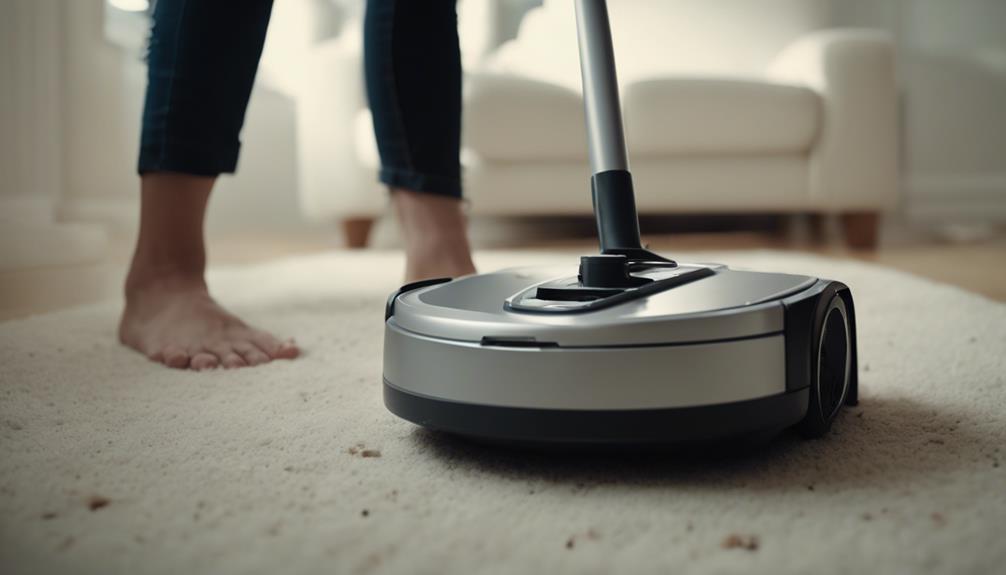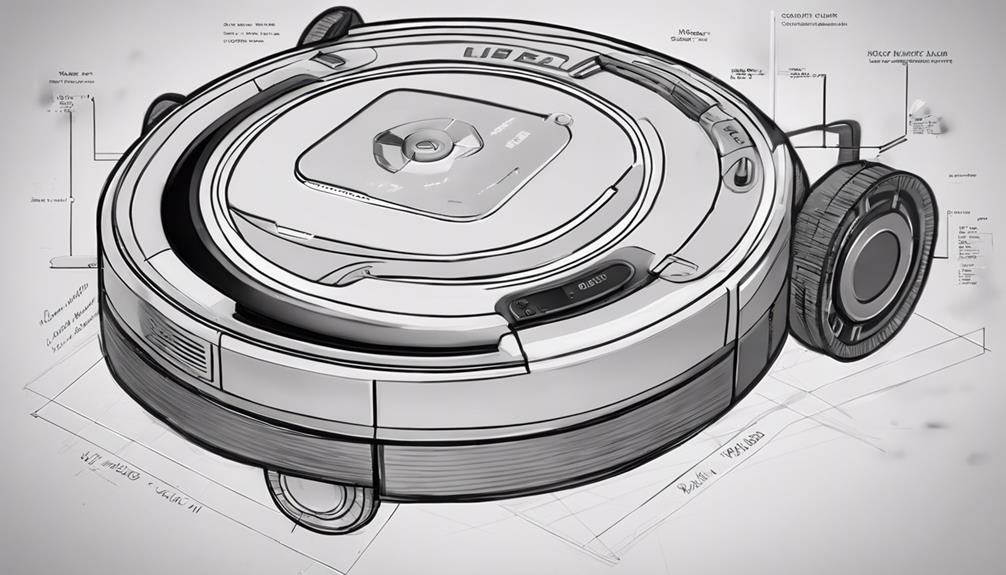In the last decade, vacuum technology‘s transformed the way you clean your home. You’ve got lightweight, ergonomic designs that make cleaning easier, along with smart vacuums that map your space for efficient navigation. Self-emptying bins save you time on maintenance, while advanced object recognition keeps your belongings safe. Plus, many models now combine vacuuming and mopping to enhance your cleaning routine. Discover more about these innovative features and how they can simplify your life even further.
Key Takeaways
- Vacuum technology has evolved with lighter materials and ergonomic designs for improved comfort during cleaning tasks.
- The incorporation of HEPA filters in vacuums enhances air quality by effectively capturing allergens.
- Smart and robot vacuums now feature advanced navigation systems, including lidar mapping for efficient cleaning paths.
- Self-emptying bins and self-cleaning mop pads have been introduced, allowing for longer cleaning sessions and reduced maintenance needs.
- Object recognition technology is now standard in many models, improving obstacle avoidance and protecting valuable household items.
Advancements in Vacuum Design and Functionality
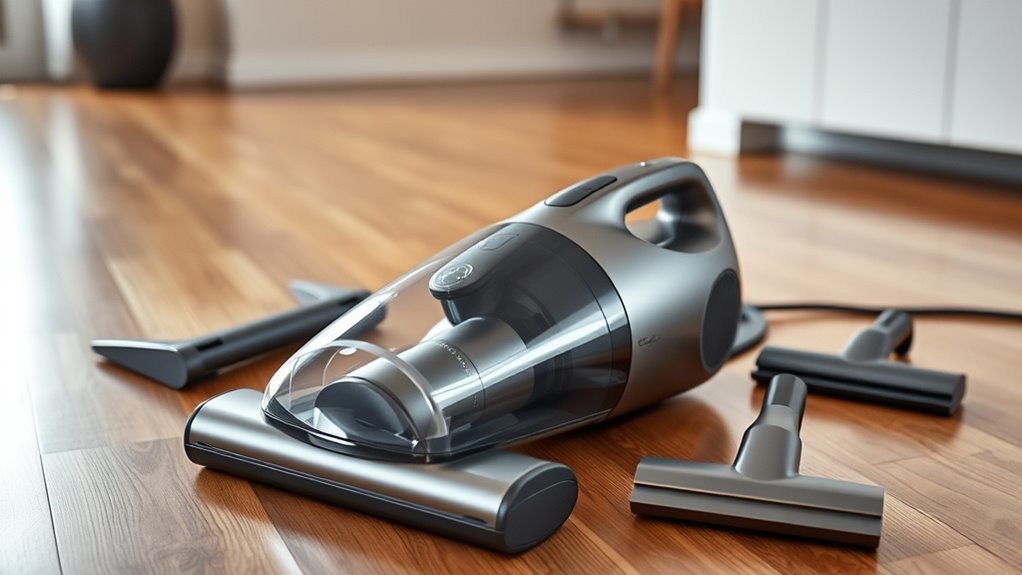
Over the last decade, vacuum technology has evolved dramatically, making cleaning easier and more efficient than ever.
You’ll notice significant advancements in vacuum design, such as lighter materials and ergonomic features that enhance comfort and maneuverability. Additionally, many of the best-rated vacuums now feature HEPA filters that improve air quality by capturing allergens while you clean. This is particularly important as air filtration plays a crucial role in reducing airborne pollutants during household chores. Many models now incorporate smart features that allow for easier operation and convenience, including integration with smart home devices to streamline your cleaning routine.
Modern vacuums now come equipped with advanced navigation systems, like lidar technology, allowing them to efficiently map your home and avoid obstacles.
Modern vacuums utilize lidar technology for precise home mapping, ensuring efficient cleaning by skillfully avoiding obstacles.
Many models even offer dual functionality, combining vacuuming and mopping with sonic vibration technology to boost cleaning effectiveness. This innovation is particularly beneficial for pet owners, as specialized brush rolls help capture fur more effectively.
Plus, the integration of smart technology means you can schedule cleanings and control your vacuum remotely through smartphone apps.
These innovations are designed to make your cleaning routine smoother and more efficient, ensuring you spend less time on chores and more time enjoying your space. Additionally, routine appliance maintenance can further enhance the longevity and performance of these advanced vacuum systems.
The Rise of Smart and Robot Vacuums
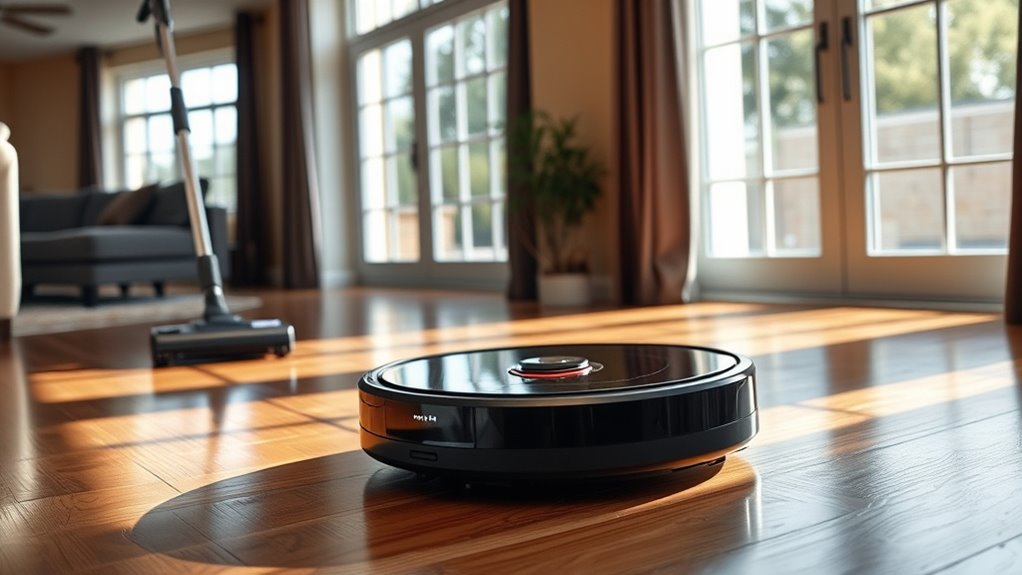
How have smart and robot vacuums transformed the way you clean your home? Over the past decade, these modern vacuums have revolutionized household cleaning.
With advanced navigation systems like lidar, robot vacuums now map your home layout, ensuring a thorough clean while avoiding obstacles. Self-emptying bins, a popular feature in midrange models, save you time and effort by reducing how often you need to empty the dirt. Additionally, the integration of smart navigation technology allows for even more efficient cleaning patterns. These advancements mirror the energy-saving features found in modern heat pumps, highlighting a trend towards greater efficiency in home appliances. Regular filter maintenance is also essential to ensure optimal performance of your vacuum over time. Many of these vacuums also boast high suction power for effective cleaning results.
Plus, improved object recognition technology helps these vacuums navigate around your belongings without causing damage. Some models even offer mopping capabilities, using sonic tech to scrub floors effectively. Additionally, many of these devices are designed to handle pet hair and fine dust, making them versatile for various cleaning needs.
With these innovations, robot vacuums provide convenience and efficiency, making your cleaning routine easier than ever.
Enhanced Navigation Technologies
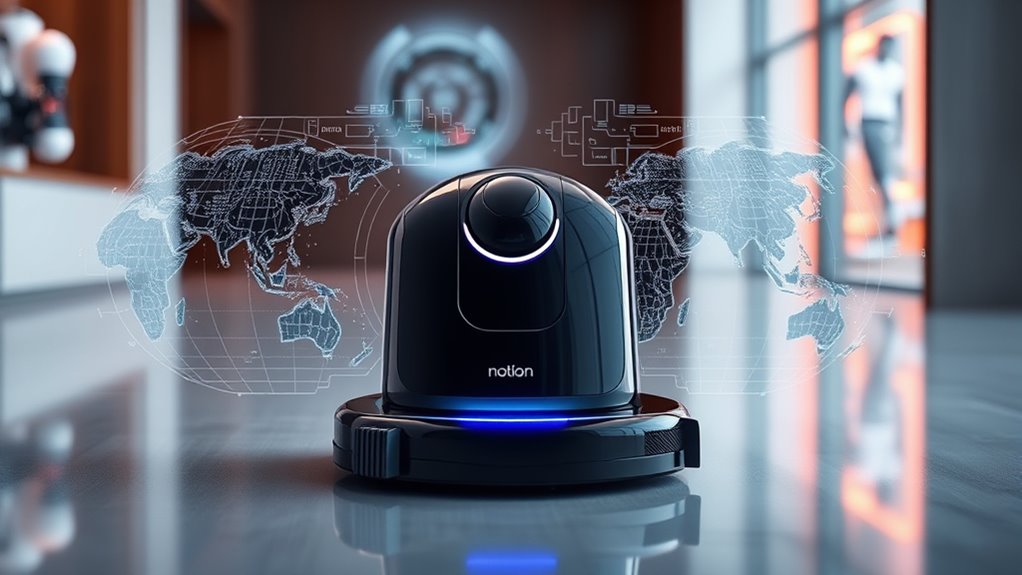
Today’s robot vacuums are smarter than ever, thanks to enhanced navigation technologies like lidar mapping. You’ll notice they create real-time layouts of your rooms and avoid obstacles with ease, making cleaning more efficient. These advancements mean you can expect a thorough clean every time, tailored to your home’s unique layout. Additionally, many modern models now integrate smart home connectivity to enhance user experience and control. This evolution in cleaning technology parallels the advanced air purification technology seen in devices like the IQAir HealthPro Series, which also focus on optimizing user convenience and effectiveness. Furthermore, similar to the energy-efficient options found in appliances like toasters and ovens, these vacuums are designed to operate with minimal energy consumption while maximizing performance. Regular use of air purifiers can lead to improved respiratory health, making them a great complement to your cleaning routine. As with car leases where monthly payments are typically lower than purchasing, these vacuums provide a cost-effective solution for maintaining cleanliness in your home.
Lidar Mapping Efficiency
As robot vacuums have evolved, lidar mapping technology has revolutionized their efficiency in maneuvering home environments. This advanced navigation system uses lidar technology to create accurate maps, allowing your vacuum to detect obstacles and plan ideal cleaning paths. Unlike older bump-based systems, your vacuum won’t waste time colliding with furniture or getting stuck in corners. Instead, it adapts seamlessly to different room configurations, ensuring thorough coverage in less time. With lidar mapping, your cleaning experience becomes more effective, as these vacuums navigate intelligently and clean efficiently. It’s no wonder that consumers increasingly prefer robot vacuums equipped with lidar technology for their convenience and enhanced performance in home cleaning tasks. Additionally, smart home automation has integrated various cleaning devices into cohesive systems, further enhancing the efficiency of household chores. This integration allows for improved color accuracy in cleaning performance, as devices can coordinate their efforts for optimal results. Furthermore, the implementation of predictive modeling in cleaning technologies enables them to adapt to users’ habits and preferences over time, ensuring an even more personalized cleaning experience. These advancements have made best vacuums for dust removal not only more effective but also more accessible, making it easier for consumers to maintain a clean home. Moreover, the rise of energy-efficient technology in cleaning devices supports sustainability goals, making them more appealing to environmentally conscious consumers.
Real-Time Room Layout
While advanced navigation technologies have transformed the landscape of robotic vacuums, real-time room layout sensing stands out as a game changer.
With modern vacuum technology, you can expect your robot to use lidar systems to create detailed maps of your home’s layout. This feature allows your vacuum to plan efficient cleaning routes and adapt to obstacles in real-time, preventing it from getting stuck in tight corners. Additionally, Tesla’s advanced safety features highlight the importance of ensuring that technology operates safely in various environments. Moreover, regular maintenance, such as filter cleaning, can enhance the longevity and performance of robotic vacuums.
Unlike early models that relied on bumpers and random cleaning patterns, today’s vacuums use sophisticated algorithms for systematic coverage. Enhanced navigation not only improves cleaning efficiency but also enriches your user experience, making advanced navigation features essential for anyone looking to invest in a robotic vacuum cleaner. Additionally, many of these advanced models incorporate safety features like auto shut-off to ensure safe operation during cleaning.
Obstacle Avoidance Technology
Building on the advancements in real-time room layout sensing, obstacle avoidance technology has become an essential component of modern robotic vacuums.
Today’s devices utilize advanced navigation systems like lidar to create detailed maps of your home, optimizing cleaning routes for efficiency. Unlike early models that relied on simple bumpers, today’s vacuums employ sophisticated algorithms to navigate complex environments.
This enhanced obstacle avoidance technology allows vacuums to detect movable objects, such as shoes and toys, preventing collisions during operation. Brands like Roborock have led the way in object recognition, ensuring that your vacuum adapts seamlessly to various home layouts.
With these innovations, you can enjoy safer and more effective cleaning, without the worry of your vacuum getting stuck in corners.
Self-Emptying and Maintenance Features

With advancements in vacuum technology, self-emptying and maintenance features have transformed the way you manage cleaning chores.
Now, you can enjoy a more hands-free experience that fits seamlessly into your busy life. Here are three key benefits:
- Self-Emptying Bins: Robot vacuums can automatically dispose of dirt into a larger container, cutting down on how often you need to clean the dustbin.
- Longer Cleaning Sessions: Many models can hold weeks’ worth of debris, allowing for extended cleaning without interruption.
- Self-Cleaning Mop Pads: Models like the Roborock S7 and S8 wash and refill mop pads automatically, simplifying maintenance.
These innovations make vacuuming easier than ever, letting you focus more on what matters most.
Object Recognition and Safety Enhancements

As vacuum technology continues to evolve, object recognition and safety enhancements have become essential features that elevate your cleaning experience.
This technology allows your vacuum to detect movable objects like shoes and toys, enabling it to navigate around these items and prevent damage. Brands like Roborock lead the way in object recognition, enhancing overall cleaning efficiency by avoiding obstacles and streamlining cleaning paths.
These advanced features contribute to safer environments, minimizing collision risks and ensuring that your valuable belongings remain unharmed. Now standard in many midrange robot vacuums, object recognition makes cutting-edge technology more accessible.
With improved capabilities, these vacuums clean your home more thoroughly, allowing you to enjoy a cleaner space without constant user intervention.
Mopping Capabilities and Multi-Function Models

How have mopping capabilities transformed the way you maintain your floors? With the rise of multi-function models, cleaning your home has never been easier.
Mopping capabilities have revolutionized floor maintenance, making home cleaning simpler and more efficient with multi-function models.
These robotic vacuums now combine both vacuuming and mopping in one seamless cycle, saving you time and effort. Here are three ways these advancements have changed your cleaning routine:
- Enhanced Cleaning: Models like the Roborock S7 and S8 scrub surfaces up to 3,000 times per minute, ensuring deep clean results.
- Automatic Maintenance: Advanced docking stations wash mop pads and refill water tanks, so you don’t have to.
- Wider Accessibility: Midrange models now offer impressive mopping capabilities, making high-tech cleaning solutions available for more households.
Embrace these innovations for a more efficient cleaning experience!
Accessibility and Affordability Trends
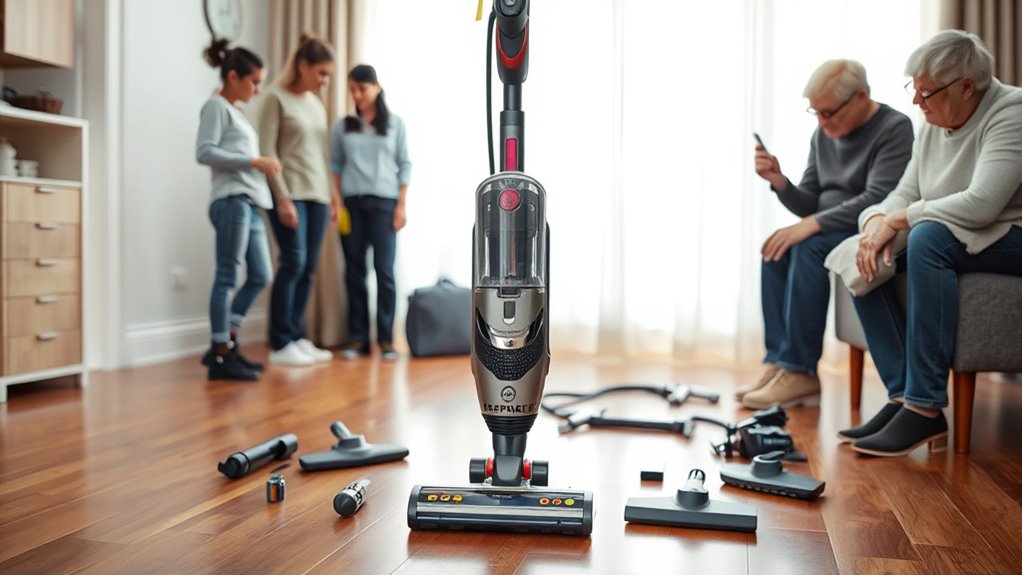
Over the past decade, a significant shift in vacuum technology has made advanced features more accessible and affordable than ever.
You’ll find that self-emptying bins and object recognition, once reserved for premium models, are now available in midrange options, enhancing accessibility for everyone.
Increased competition among manufacturers has spurred innovation, driving prices down and allowing a broader audience to enjoy these advancements.
With improvements in usability and efficiency, robot vacuums have become more user-friendly, appealing to a larger market segment.
The introduction of advanced navigation and mopping capabilities in these midrange models further boosts their value, catering to budget-conscious consumers and those seeking high-tech features.
This trend reflects a growing demand for automated cleaning solutions that fit various lifestyles.
Frequently Asked Questions
How Did the Vacuum Cleaner Change Over the Years?
Over the years, you’ve seen vacuum cleaners transform from heavy, horse-drawn machines to sleek, portable electric models.
You remember when bagless designs became popular, making cleaning easier and more efficient.
Nowadays, robot vacuums are your go-to for convenience, guiding your home with smart technology.
With features like self-emptying bins and mopping capabilities, these modern vacuums save you time and effort, making the chore of cleaning much more manageable and efficient.
Have Robot Vacuums Improved?
Absolutely, robot vacuums have come a long way!
They’re like your personal cleaning assistants, now equipped with advanced navigation using lidar technology to map your home.
You’ll appreciate the self-emptying bins that save you from frequent clean-outs.
Plus, their improved object recognition means they dodge your shoes and toys like pros.
With models featuring mopping capabilities, you’ll enjoy an even deeper clean, all while being more affordable and accessible than ever.
What Impact Did the Vacuum Cleaner Have on Society?
The vacuum cleaner’s impact on society has been profound. It transformed cleaning from a labor-intensive chore into a quick task, making it accessible for everyone.
You’ve likely noticed how it freed up time, allowing people, especially women, to engage more in the workforce.
With its efficiency, the vacuum cleaner not only maintained cleanliness but also contributed to the rise of modern household dynamics, showcasing a shift in gender roles and enhancing overall quality of life.
What Were Vacuums Like in the 1920S?
Imagine a bustling home in the 1920s, where dust dances in the sunlight.
You’d find compact, electrically powered vacuum cleaners replacing bulky horse-drawn models. The sleek canister vacuums glide effortlessly across floors, offering flexibility and ease.
The iconic Hoover Model 700, with its self-propelled mechanism, showcases innovation with various attachments.
Conclusion
So, if you’re still lugging around that old vacuum like it’s a relic from the Stone Age, it’s time for an upgrade. With smart vacuums that practically have a PhD in navigation, self-emptying features, and even mopping capabilities, you might wonder if they’ll start planning your dinner next. Embrace the future, where cleaning is done by machines, leaving you free to ponder the truly important questions—like how did you ever live without a robot vacuum?


